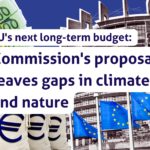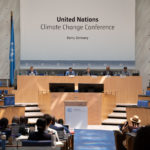Unprecedented levels of global energy price increase and volatility due to the EU’s systemic dependence on fossil gas started surfacing by the end of 2021. In order to shield consumers (households, businesses and industry) and overall economies, European governments started implementing short-term energy market interventions. In the meantime a debate about the functioning of the European internal electricity market developed, with Member States and other stakeholders putting pressure on the European Commission to take action, which accelerated with Russia’s invasion of Ukraine in February 2022.
The Commission’s May 2022 REPowerEU Plan came out with additional communication pieces, including one on “Short-Term Energy Market Interventions and Long Term Improvements to the Electricity Market Design – a course for action”, proposing some short-term EU-wide intervention measures while signalling potential structural changes in the electricity market design to make it better suited to “future price volatility and fit for the future decarbonised energy system, with an increasing share of renewables in electricity production”. The European Commission, informed by a detailed analysis of the EU wholesale electricity market design by the Agency for the Cooperation of Energy Regulators (ACER), concluded that the wholesale market delivered efficiently as a well integrated market, allowed Europe to reap all the benefits of a single energy market, ensuring security of supply and sustaining the decarbonisation process. The Commission also acknowledged that improvements will be needed “to ensure affordable energy for everyone all the time, protecting consumers against high and volatile energy prices, ensuring investments in supply solutions, and enhancing flexibility to reduce peak demand – thus, peak prices”.
After a series of emergency intervention measures proposed by the Commission through the ongoing gas crisis, a targeted reform of the electricity market design was announced to kick off early 2023 with a public consultation, but without an impact assessment of the implementation of the existing market design that was adopted in 2019 as part of the Clean Energy Package.
Considering structural changes in the relatively recently adopted, and barely implemented, electricity market design during “war time” is very risky. The Commission must be extremely clear to orient the reform around strengthening the market design to work for the consumers, unleashing the people-power for a renewables-based system, especially because the reform will likely be transposed in two years time the earliest and probably in a different context. Any impulsive reaction to the current war context, due to massive pressure by Member States trying to run their costly fossil fuel or nuclear energy infrastructure for longer due to energy security concerns, carry huge risks for achieving an energy system which puts people in the center, accommodates and accelerates the intake of 100% renewables, and helps deliver the EU’s Paris-agreement commitments.
Although the Commission has been explicit about bringing a targeted reform, without an intention to amend the core of the internal market functioning and price setting, the design of the internal electricity market is so complex that any changes to certain elements of the market may have implicit implications for other elements. Therefore, we strongly recommend that the Commission frames targeted amendments as part of an accelerated plan to achieve a consumer-centric, decentralised, strong and flexible electricity market to fully run on variable renewables, valuing demand-side measures as proper resources balancing the supply-side in harmony.
Reforming the electricity market design is not a silver bullet. The EU’s commitment to deliver its fair share under the Paris Agreement, as well as the urgent need for secure, reliable and affordable energy means that there is an urgent need to transform the European energy system. And reforming the market design alone, will not make the needed transformation happen. Focusing limited time and resources on amending the existing market design also draws attention and efforts away from properly implementing those provisions of the Clean Energy Package which could have done much to alleviate the negative impacts of the current fossil gas and cost of living crisis (e.g. empowering energy communities and unleashing the full potential of demand-side flexibility).
Beyond the changes in the market design, deploying ambitious energy saving measures, scaling and speeding up renewables in a nature-positive manner, expanding transmission/distribution grids and using the existing grid infrastructure more efficiently, shifting taxes away from electrification to gas and from households to polluters, phasing out fossil fuel subsidies as well as implementing the existing electricity market design to empower individual/collective self-consumers and energy communities are mandatory pieces of the puzzle.
Ensuring a strong long-term electricity market for renewable energy sources is crucial as the current gas crisis and COVID crisis showed the clear weaknesses of relying mostly on the short-term market’s price signals: by putting households and enterprises under pressure because of high gas prices, and because of the extreme compression of the wholesale prices (that weren’t mostly passed on to retail users), and which would, if sustained, have put new renewables investments in doubt during the COVID crisis.
However, short-term markets are fundamental to give the right signals to incentivise demand-side measures (including energy savings, demand-side flexibility and self-consumption). Therefore, CAN Europe does not support any proposal that would put clear price signals to activate flexibility at risk.
The Energy Efficiency First (EE1st) principle must guide the reform process with a systems approach as explained in the Commission’s 2021 recommendations and guidelines. As an overarching principle, it should help systemically bring supply and demand-side resources (energy savings and demand-side flexibility) on an equal footing: need to aim not only at technology neutrality but at technology inclusivity, both need to be treated as power system resources to receive the value they bring to the system in an equal way.
This briefing lays out CAN Europe’s vision and preliminary proposals for the reform of the internal electricity market design (EMD) on the table. It analyses the Commission’s consultation paper and questions, through the lens of CAN Europe’s three main objectives: A Paris-agreement-compatible energy transition to achieve 100% renewables, coupled with maximum energy savings, by 2040; strong, resilient and flexible markets; affordable energy for all and just transformation. It proposes measures for the short-term, long-term/ forward and retail markets in the scope of the EMD reform.
Due to the characteristics of the Commission’s consultation and the-three-week timeline to respond to detailed questions – in many cases without an option to explain short answers, as well as having to respond to a consultation without a detailed impact assessment, constraints this paper to be a detailed feedback to the consultation.
Download full briefing here.



